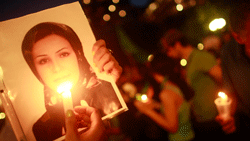We Watched a Woman Die. Now Let's Look Away.

Hanna is right about the Neda video . We really don’t have any idea what it records, except a young woman bleeding to death in the street. And ultimately that’s what is most arresting about the film: the experience of watching someone die. Like so many others, my reaction to it has been visceral. The first time I saw it, I burst into tears. Later, I focused on the whites of her eyes, the blood streaming from her mouth.
My interest in these details has nothing to do with my support for the protesters in Iran or my anger at her assassin, and it says absolutely nothing about who that assassin might be. It springs from my awareness of the vulnerability of the human body, and my physical empathy with this particular body in the moment it becomes a corpse. Meghan gets at this when she writes that the sight of Neda dying "is so difficult to hold in the mind that we have to transform it," and that in making Neda’s death stand for more than the death of a single young women, we "rob it of meaning." This is the same problem we encounter when we mix art, which captures the reality of life and death, with politics, whose aims are far more utilitarian. I don’t mean to suggest that the Neda video is art. But like art, it captures a profoundly significant moment in human existence, and that’s why it moves us. It’s the record of an individual death, not a revolutionary struggle.
On a purely journalistic level, as Hanna notes, nothing in the e-mail Sullivan posted or the LA Times story confirms that a Basij sniper shot Neda Agha-Soltan. The doctor’s account is just one of many that would be weighed in an investigation, and his e-mail appears saturated with the residual drama of the moment (the sniper aiming straight for her heart), to say nothing of how hard it is to know where a bullet originates in the midst of a street demonstration.
There’s undoubtedly more to the story than we know, and if we’re lucky, more details will emerge in time. But now that millions of people have watched this young woman die on YouTube, I’d like to suggest something radical: Let’s back off. Privacy was not something Neda enjoyed in her final moments, but this death is hers, not ours. The violent end of a life is a powerful thing to see, whether it happens on a street in Tehran or in Washington, D.C. In our attempts to magnify its importance, let’s not make it less than what it is.
Photograph of a vigil in New York City by Mario Tama/Getty Images.
